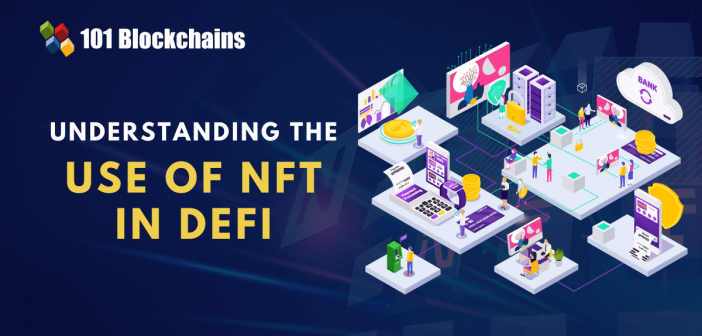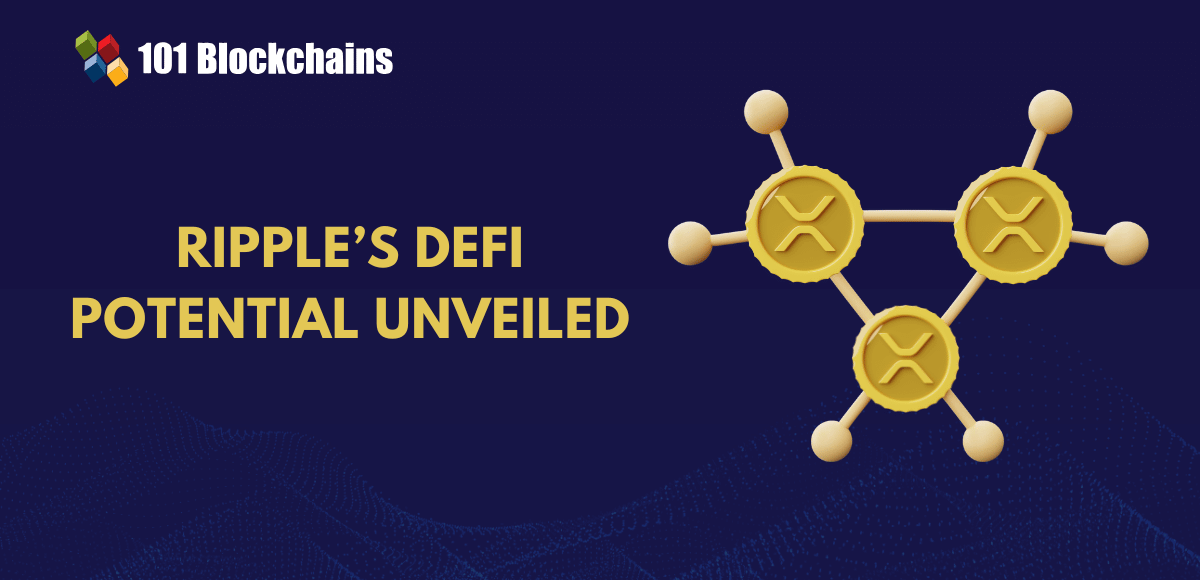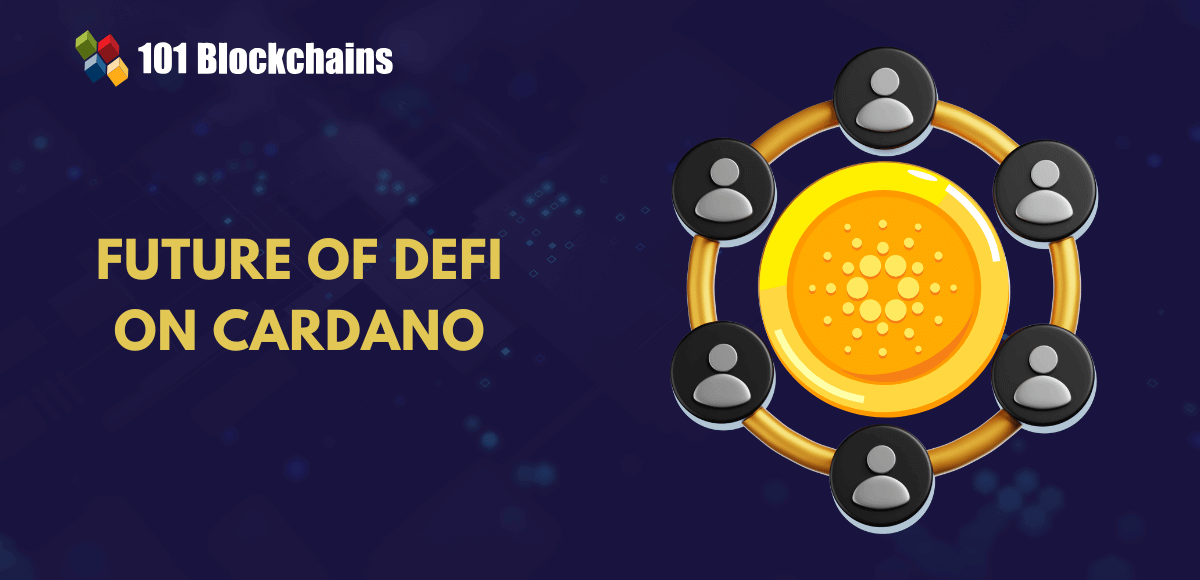Learn how blockchain truly works, master key definitions, and uncover what makes smart contracts so "smart." Dive into the fundamentals, gain valuable insights, and start your blockchain journey today!

- Decentralized Finance
Gwyneth Iredale
- on September 15, 2021
How Can NFTs Be Used in DeFi (Decentralized finance)?
The two most prominent trends in the existing crypto market refer to DeFi and NFTs. Decentralized finance and non-fungible tokens are presently the two most popular applications in the domain of blockchain technology. DeFi offers decentralized access to financial services while non-fungible tokens focus on enabling tokenization of assets. However, it is important to reflect on the possibilities of leveraging the NFT DeFi combination for the benefit of enterprises.
On the other hand, it is reasonable to wonder about the evolution of NFTs as a suitable instrument for DeFi. NFTs are often considered as just digital art or collectibles which are fetching huge prices in auctions due to hype. However, non-fungible tokens can serve exceptional contributions to the growth of decentralized finance in the long term. The following discussion helps you find the possible ways for achieving the best value from NFT use in DeFi.
What are NFTs and DeFi?
Non-fungible tokens or NFTs are just a unique way of storing value. Just like gold or a dollar bill, NFTs have their value locked in a particular asset. The estimate of the NFT’s value differs profoundly on the market and individual levels. It is difficult to replace or replicate non-fungible tokens easily thereby implying that two NFTs cannot be the same. Decentralized finance or DeFi is basically a financial system based on blockchain technology. Many public blockchain networks such as the Ethereum blockchain contribute to the development of the DeFi ecosystem. DeFi opens up the door to decentralized financial management through different in-built tools such as cryptocurrencies, oracles and smart contracts. The definitions of NFT and DeFi clearly indicate the possibilities for discovering a link between them.
So, where do you start discovering the association between DeFi and NFT? Looking at their definitions, you can clearly notice that NFT offers a unique way for storing value and DeFi offers an infrastructure for unlocking value.
Want to know more about DeFi? Enroll Now in Introduction to DeFi Course
How Do NFTs Store Value?
In order to understand the possible NFT decentralized finance link, it is important to know the type of assets which can be tokenized. Tokens with realistic value propositions such as real estate are one of the first examples of NFTs. Real estate investments were highly illiquid and demanded lots of documentation. Bringing the assets on blockchain in the form of virtual tokens can help in the easier representation of ownership and flexibility for transfer. In addition, NFTs could help in unlocking and mobilizing value in cases where it was difficult to mobilize value. For example, music artists could offer NFTs as tokens for participating in direct engagement sessions with them. The value of the offering is an important factor for determining the value in them. Since NFTs offer a value proposition, it has to be priced.
Want to get an in-depth understanding of non-fungible tokens (NFTs)? Enroll now in the NFT Fundamentals Course.
How Does DeFi Unlock Value?
Exploring the definition of DeFi further could help a promising idea of the foundation for NFT use in DeFi. The first thing you need to understand regarding DeFi is that it can work effectively with different types of financial solutions, instruments, and processes. NFTs would basically become another asset in the existing portfolio of DeFi. However, it is also important to find out the stream which would be influenced the most by the introduction of NFTs into the DeFi space.
NFTs are basically value-based assets. Therefore, they can provide the possibilities of growth in the asset’s value or accruing income from the assets to the owner. DeFi can offer the opportunity for unlocking the value from NFTs. How?
The arrival of NFTs in DeFi Ecosystem
The design patterns in the world of decentralized finance or DeFi are gradually intermingling with NFTs and NFT marketplaces. Just like many other DeFi projects, Rarible, offers an NFT marketplace focused solely on creators. It offers a governance token known as RARI and also implemented the necessary mechanisms for regulation under a Decentralized Autonomous Organization (DAO). The RARI token holders, including creators and collectors, could vote for the platform upgrades alongside participating actively in moderation of the marketplace. RARI has also featured an NFT index, which serves as a portfolio for NFTs to help all collectors view the artworks and choose the right one for investment.
Want to explore in-depth about DeFi protocol and its use cases? Enroll now in Decentralized Finance Intermediate Level Course
Using NFTs in Decentralized Finance
The NFT decentralized finance combination becomes instantly feasible, especially with the capability of NFTs to represent the commercialization of digital products and services. NFTs have become one of the promising applications in the DeFi sector. For example, Ethereum has introduced ERC-20 tokens for offering representation for digital assets. So, NFTs could easily serve as proof of ownership rights for digital art. Ethereum has become one of the top choices for creators to share art and interact with an engaged community of collectors. With the flexibility for proving ownership, NFTs could serve exceptional value advantages in the domain of DeFi. Let us take a look at the different possible ways for NFT use in DeFi.
-
Resolving the Problem of Collateralization
One of the foremost aspects of the NFT DeFi combination is the capability to unlock value. At the same time, it is also difficult to round up on specific mechanisms for ensuring determining the value of NFTs. However, the use of NFTs could help the lender determine the collateralization amount in DeFi. How? The borrower would request a loan amount with the NFT that will serve as collateral. The lender would evaluate the loan amount alongside the collateralized NFT with consideration of different factors such as the owner’s price tag, a secondary market value, and their individual calculations.
The use of NFT and DeFi in unison could help in solving the problem of collateralization easily. It is also important to notice the troubles due to issues in the liquidity of the market. The domain of artwork and collectibles is quite subjective in terms of liquidity. For example, assume that a painting is priced at almost $1 million. However, the price of the painting holds value only when an individual is interested in paying for it. The NFT decentralized finance association could easily resolve the issues of collateralization for artwork. The most plausible solutions, in this case, might focus on using NFT art and collectibles as collaterals in DeFi lending.
Traditional art has been used conventionally as collateral in the real world. Therefore, transitioning NFTs into the domain of DeFi definitely seems like taking a reasonable step towards the future. NFTs could also improve the DeFi sector through the resolution of liquidity issues by enabling tokenization. Tokenization could offer the ease and flexibility of preparing an illiquid asset faster than possible.
Want to know more about tokenization? Enroll Now in Tokenization Fundamentals Course
-
Addressing the Concerns of the Curve Model
The next important highlight related to NFT use in DeFi refers to the working of these two instruments for addressing the problem of the curve model. The curve model was basically tailored for the distribution of liquidity through the while curve. It emerged with one of the recent versions of DeFi protocols associated with liquidity pools. However, the curve model in DeFi also implies the substantial build-up of liquidity without any returns for the providers. However, the NFT DeFi combination has successfully offered the facility for the selection of desired custom price sizes for liquidity providers. As a result, liquidity providers could easily evaluate their capital and addressing the liquidity build-up in the curve model. Subsequently, liquidity providers could also again higher exposure to desired assets alongside achieving reductions in downside risk.
-
NFT Ownership and Its Impact on DeFi
The examples of using DeFi platforms in association with NFTs for the music industry clearly imply a revolutionary change in the world of art. Furthermore, NFTs have found a crucial role in allowing ownership rights and profits to the actual creators. The owners of NFTs can earn a reliable share of the streaming revenue or resale value of their works. In addition, maintenance of verifiable earnings through NFTs also offers an effective variant of collateral. It can also enable easier access to the under-collateralized loans which is not possible without NFT use in DeFi. The monetization of art and collectibles through NFTs has become an integral part of the whole narrative of NFT hype. However, NFTs could become greater instruments for addressing the concerns of royalty sharing, licensing, and copyright ownership.
Another important aspect regarding the use of NFT DeFi together is the concept of fractional ownership. NFTs also allow the flexibility for the creation of shares of the NFT. As a result, investors and fans of NFT creators could get the opportunity to owing NFT without purchasing the whole NFT. However, the applications of fractional ownership of NFTs in the DeFi space are still in the initial stages.
Build your identity as a certified blockchain expert with 101 Blockchains’ Blockchain Certifications designed to provide enhanced career prospects.
Conclusion
One of the most important factors associated with the applications of NFT and DeFi together is the verifiability of ownership. The ease of proving NFT ownership opens up the DeFi space for NFT holders to obtain loans with NFTs as collateral. Most important of all, it is important to know that NFT has the capability for allocating value to almost anything. DeFi, on the other hand, helps in unlocking the value of a specific asset. NFT-backed loans are slowly gaining popularity and the growth of NFT DeFi as one would spell broader horizons of innovation. With the rising number and depth of users, DeFi and NFTs could transform the way we view assets, tokens, and financial services.
*Disclaimer: The article should not be taken as, and is not intended to provide any investment advice. Claims made in this article do not constitute investment advice and should not be taken as such. 101 Blockchains shall not be responsible for any loss sustained by any person who relies on this article. Do your own research!




![30+ Best Decentralized Finance Applications [Updated] best decentralized finance (DeFi) applications](https://101blockchains.com/wp-content/uploads/2020/10/decentralized-finance-applications.png)

